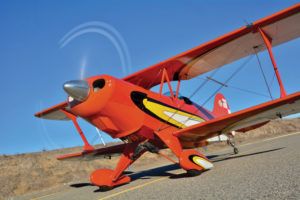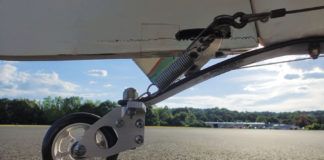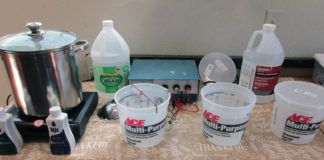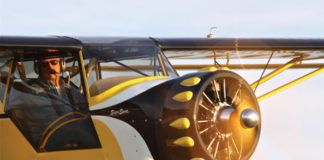From the dark closet of unanswerable questions one has resurfaced in my orbit lately: to warm up or coldly go into the takeoff? This one is so full of variables it’s a model farm for the critics, so let’s get to it.

Warming advice ranges from avoiding the mag check until palm trees grow out of the cowling to a polite 20 seconds from yelling “clear” to takeoff power. And to be clear, let’s also note we’re not talking about preheating with electric blankets or trained dragons as practiced in snowy climes (a good idea, for sure). No, here we’re addressing typical clement operations. We can also assume we’re talking the usual LyConentals and not the liquid-cooled Rotaxes or 985 Pratts with 25 gallons of oil attached.
Furthermore, while we just agreed preheating is not the topic, Lycoming generally says to preheat at 10° F or lower temperatures, and failure to preheat can result in “minor amounts of abnormal wear” (each time preheating is omitted one presumes), plus TBO is shortened by some unspecified time (so the damage is cumulative). So there is something to operating well below the green arc.
In fact, there are three certain issues with cold engine operation: poor lubrication from halting oil flow, somewhat variable engine clearances during warm-up and metal stress from rapid heat cycling. That warm oil flows more readily than cold oil is hopefully so self-evident we can quickly move on. But what isn’t perhaps so universally understood is just how obstructive to flow 50-weight oil can be at something like 45° F, let’s say. In short, 50-weight oil doesn’t flow so much in the 40° range as reluctantly agree to move, if you insist. It’s more like cold pancake syrup at such temperatures. And just like those bubbles that maddeningly stick in the handle of the syrup jug, given tight oiling passages and 90° fittings such cold oil would just as soon hydraulically lock than anything else. I learned that lesson racing a junk Austin-Healy Sprite back when. It needed straight 50 weight to maintain maybe 40 psi of oil pressure at its typical 240° F oil operating temps but exhibited all sorts of scary behavior on the oil pressure gauge when started cold. Stock rated at 54 hp, mine showed 91 hp on the dyno and had a TBO of, no joke, eight hours. The bearings always came out wiped to the copper.
Expansion and Contraction
As for engine clearances, these definitely change with temperature, although we can observe parts don’t fall off after a cold night in the hangar and it’s still possible to crank the engine in 120° F weather. But piston-to-wall clearance does change meaningfully—the piston has more clearance when cold. Perhaps this isn’t a huge concern by itself, but in our loose, 5.125-inch bore, air-cooled engines it doesn’t do wonders for correctly presenting the piston ring to the cylinder wall as the piston rocks. More blowby is the result. Furthermore, with our air-cooled engines, which expand and contract like a frog’s throat on a PBS special, compared to the legions of the water cooled, there is all sorts of stretching and general metal fidgeting going on as the engine warms up from dead cold. That’s why the torque spec for through-studs is a puny mid-30 foot-pounds or so; the engine is cold and the case and studs shrunk when the engine is assembled. At operating temperature the aluminum case has grown much more than the steel studs, resulting in an effective torque spec more in the 60-foot-pound range. This has consequences for main bearing crush. It’s also more of a factor with hot rodded engines as their clearances can be more critical than less highly stressed pancake chasers, plus engines in the deep-breather class make more heat faster than their standard stablemates. This is where the heat cycling stress comes into play. We all know about shock cooling engines during rapid descents; similar stress can be induced going from cold to hot, especially with hot rodded powerplants. For sure things are stretching rapidly if the cylinder head fins are 185° F and the EGT suddenly goes to 1400° F.
Offsetting the cold oil flow issues are multi-viscosity oils. By offering far less resistance to flow when cold, they help avoid hydraulic locks and generally get the oil where it needs to be faster. They also help starter cranking speed, which is a good thing when trying to get a big engine lit in cool weather. But they don’t do much, if anything, for blowby and metal stress during high-output, cold engine operation.
So, is going to full loud on a cool engine going to present you with a halo of connecting rods in your immediate future? Not likely. But you could soon be seeing the connecting rods—in a controlled fashion, thankfully—when the engine is torn down for overhaul a little earlier than you’d like. Maybe. It’s all so difficult to specify accurately because so much depends on the weather, how far the hangar is from the runway and so on. But this experiment has been run many thousands of times and the results are in: Engines carefully operated by professional pilots and ground crew almost always sail far past their published TBO specification. Engines treated like rented mules don’t.
Rules for Run-Ups
All said, what is a reasonable rule for warming up? Not to cop out, but it depends. I routinely operate an O-200 Continental and a hopped-up IO-540. The little Continental is stone stock with an anemic 7.0:1 compression ratio, and during the summer it gets no more warm-up than however long it takes to drag it to the runway, which is about four minutes given the usual run-up. We typically keep the mixture full rich (sometimes we lean it on the ground, not that it seems to make any difference), the rpm stays a bit above idle and just four quarts of 20W-50 in this engine is plenty as it blows any extra out the breather. In winter an extra minute or two apparently does the trick. Generally speaking this engine, which has been around the patch more than a few times—what O-200 hasn’t by now—has the usual slobbery demeanor about the intake system and the also typical lead-fouled, somewhat oily spark plugs at annual time. That’s not to say it isn’t well cared for or the carburetor is not in correct tune, which it is, but rather that it’s an old-school, low-performance, low-stressed engine with pretty ample mass considering its so-so power output.
The 10:1 compression 540-EXP gets a whole nother level of preflight care. Our Southern California base means “cold” weather is possibly in the high 30s during the night and it’s always at least in the low 40s during early-morning engine starts. Even with just 10 quarts of 20W-50 in the sump I’ve found that manually pulling the engine through six blades helps the high-speed starter get the first blade through that first, tough compression stroke when the weather is that cool. It wants full-rich mixture for the first 90 seconds or so, then I begin leaning by ear to achieve the smoothest possible 1000-rpm idle. The elevated rpm provides splash oiling to the cam, lifters and cylinder walls while the leaning reduces lead deposits and general goo accumulation as the EGTs aren’t high enough to scavenge the lead.
Like the O-200, the 540 is taxied to a run-up area some distance from the runway at our unusual, hilltop runway for a CIGAR minus the R check, still with a 1000-rpm idle and increased leaning as the engine warms up. A six-channel engine monitor allows watching the CHTs climb but it’s mainly the oil temperature that gets the eagle eye. Once the needle comes off the 100° F lower peg I’ll taxi to the runway, go full rich on the mixture and give it a 1700-rpm run-up. Then it’s leaned again until takeoff. Believe me, you won’t get very far on takeoff with the mixture leaned.
In winter it can take as much as 12 minutes of ground operation to get the engine ready for takeoff. That’s a long time, especially when half of that is just making noise and you’re sitting outside behind that big fan in an open cockpit. In spring and fall the wait is more like 7 minutes and in summer it’s nice that she’s ready to go just as soon as I can reasonably get to the runway. But consider that unlike the O-200, which goes to what, 7 gph at takeoff and is seemingly designed to live at 80% power because there isn’t much of that, the 540 wraps the analog fuel-flow needle off the scale at takeoff (the dyno put it at 29 gph) as it churns out over 300 hp. There’s a whole lot of heat coming on strong at takeoff and the engine only has 400 pounds of mass to absorb it. In short, it’s strong enough to hurt itself and needs to run in a narrower temperature range to keep the clearances and lubrication in their happy spots. That’s why it can boil those 10 quarts of oil just a few minutes after takeoff if you don’t either pull off some power or pay attention to air through the cowling.
The 540 is a big ’ol loose airplane engine so it shows just a little blue stain slobber in the inlet tract during inspections, but the spark plugs come out clean with rarely a lead clinker to pick out thanks to the lean running (it runs full rich only at takeoff). Unlike the O-200, which is apparently incapable of feeling pain unless asked to climb above 5000 feet, the 540 takes some attention in flight, mainly getting it to 18 gph at high-power cruise or under 12 gph running lean of peak at mumbling power outputs lest it sneak a fuel siphon into your wallet.
So, do I warm up before takeoff? It depends, but go ahead and take off. I’ll catch up in a few minutes.














Warm oil is good. I will sit in the runup area with the engine leaned and at 1,400-1,500 rpm, [ GO-300 Cont.], until I see the oil temp needle come off the peg,, which in my old Cessna is 90 degrees F.. In my Northern California area, it can be 10 minutes at 50 degrees F. OAT.
The cylinder temps are then usually approaching 300 degrees, so it’s then time to go.!
I have noted that a takeoff with ‘cold’ oil I will see 200-300 fpm less than if the oil is at 180 degrees, and 1,000-1,100 fpm.
Some googling has noted that an engine can lose 10 hp trying to pump cold, thick oil.
Funny this should come up here at this time….well, sort of funny. Just a couple of days ago from writing this, on a 20 something degree Michigan day just before taking 28 at Y70, I noticed my oil pressure gauge reading z e r o. My first thought was a faulty gauge reading but discretion won out ( thankfully ) and I taxied back to find my 0-200 A powered Tailwind W8 had taken on a distinctive oil color. The culprit was a blown oil filter gasket. Loose oil filter? Too much pressure from not sufficiently warming the oil? A combination of both? Not sure. What I am sure about is 1. I am extremely glad this happened on the ground and not 30 seconds later. 2. An oil filter check is now in my preflight. 3. I will do a much better job of warming the oil in Michigan winter.
Post Script…. After cleaning up the airplane, a new oil filter, 3 quarts of fresh 20W50 and a ten minute run up, an hours worth aerial engine abuse and all was well. Yes, the fresh oil was preheated before start up
Doran–Having once lost all oil pressure in flight we agree, it’s better to do that on the ground! Tough to say why your oil filter gasket failed (you listed the usual culprits), but the high oil pressure from cold oil no doubt contributed. — tw
Thanks for the reply. The abuse was in the form an hours worth of maximum performance take offs and landings. Rechecked everything. All was well.
Any other input I am open.
All the Best to You.
Doran Jaffas
N625MS
Y70
Turning the prop a few turns, in my opinion, just wipes the oil off the cam that doesn’t get replenished for a few seconds after starting. A precious drop will hang on the cam lobe for months if the engine isn’t turned over. If you feel the need to loosen the oil up, rock the prop back and forth a little and then start it. Keep the oil where it’s needed instead of wiping it off.
Warming up the engine and oil is critical if an engine is going to live a good long time. And when starting cold, not letting the engine burst to life at 1500 rpm! Keep it down low, around 800 until and after the oil pressure has come up for at least a few seconds before bringing the rpm up to a 1000 or so. The cam is turning half the speed of the crank so when the cam is turning at 400 rpm, the lifters, stiff in their tight clearance bores, have a chance to start rotating on the cam instead of skidding and possibly galling.
And one more thing. The crankshaft is a heavy piece of steel that takes a little more time to warm up. Just because the oil temp comes up, say 80F, doesn’t mean it’s flowing nicely through the oil passages in that 30 degree crankshaft. It takes a little extra time before all that steel and aluminum that is a long way from the hot combustion to warm up. So one can figure the oil hits those cold oil passages and slows down back towards that honey viscosity for longer than you might think. So be nice and give it and extra couple minutes.